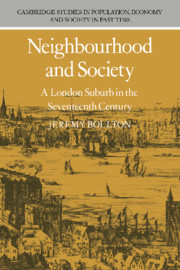Book contents
- Frontmatter
- Contents
- List of figures
- List of tables
- Preface
- Abbreviations
- 1 Introduction
- 2 The demographic background
- 3 Earning a living in early seventeenth-century Southwark
- 4 Wealth and social structure
- 5 Household structure and the household economy
- 6 Power, status and social mobility
- 7 Residential patterns and property ownership
- 8 The dynamics of a local community
- 9 Social relationships in the urban neighbourhood
- 10 The institutional structure of the neighbourhood
- 11 Conclusion: neighbourhood and society in seventeenth-century London
- Bibliography
- Index
9 - Social relationships in the urban neighbourhood
Published online by Cambridge University Press: 19 October 2009
- Frontmatter
- Contents
- List of figures
- List of tables
- Preface
- Abbreviations
- 1 Introduction
- 2 The demographic background
- 3 Earning a living in early seventeenth-century Southwark
- 4 Wealth and social structure
- 5 Household structure and the household economy
- 6 Power, status and social mobility
- 7 Residential patterns and property ownership
- 8 The dynamics of a local community
- 9 Social relationships in the urban neighbourhood
- 10 The institutional structure of the neighbourhood
- 11 Conclusion: neighbourhood and society in seventeenth-century London
- Bibliography
- Index
Summary
Community and neighbourhood in pre-industrial cities
Studies of sixteenth-century provincial cities tend to use the term ‘community’ to describe either the whole city or an urban ‘sub-community’ within it. Dyer thought the urban parish ‘a very distinct community to those living in it’ but also went on to make the unsupported claim that ‘parishes in their turn must have been broken down into street communities’. Phythian-Adams also noted the ‘informal grouping of people into…the neighbourhood’ in early sixteenth-century Coventry and pointed to the evidence for street parties and maypoles as indication of neighbourhood solidarity. The neighbourhood and street communities sometimes identified in pre-industrial cities are thought to be bolstered and maintained by a number of formal and informal institutions. As we shall see in Chapter 10 participation in, and the scope and effectiveness of, local government and church life are often thought to represent the formal foundations of neighbourhood life. Less formally, residential patterns are thought to provide another basis for social cohesion. The ‘degree of contact and intimate intermingling between the various social groups’ is stressed in York, Worcester and Coventry. The existence of the ‘sub-community’ in Worcester was demonstrated by the frequency with which ‘friends and relations all lived in the same small area’; while Phythian-Adams produced some evidence intended to show that kinship ‘lent some reality to the concept of neighbourhood at the street level’.
- Type
- Chapter
- Information
- Publisher: Cambridge University PressPrint publication year: 1987

